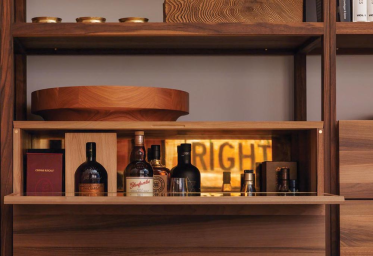
The MultiPly project by Waugh Thistleton Architects showcased the diverse applications of American tulipwood and Cross Laminated Timber
From thermal insulation to acoustic absorption – innovative uses of hardwoods are making our interiors look good, sound better and feel warmer than they have before, with the added benefit of sustainability thrown in.
Let’s start with the looking good bit because, as we all know, looks can be deceiving but when it comes to timber, that isn’t always a bad thing.
American tulipwood, first discovered by early settlers to the US in the 1500s, was fancied for its aesthetic similarities to the European poplar tree and rapidly gained popularity with Italian furniture makers as other tropical hardwoods became difficult to access. Initially, the attraction was to the matching and finishing qualities of the timber as well as its superior strength and hardness compared to that from poplar or willow trees.
These qualities made tulipwood ideal for furniture and also picture framing though, due to the nature of the trees themselves, the timber is also perfect for joinery where long lengths that are stable and knot-free are highly sought after. This, combined with the varied colours found in the tulipwood and its ability to regenerate rapidly, continues to make it one of the most widely used American hardwoods across the globe.
Recently, through the progression of thermal modification, tulipwood is being used in new ways – offering an alternative to species such as walnut.

The Hungry Fox by Lukas Partners uses thermally modified American tulipwood through its exterior and interior.
On the outskirts of Melbourne, the Hungry Fox café by Lukas Partners has put tulipwood through its paces on the exterior, and has also been used extensively on the interior. The project is a testament to tulipwood’s versatility with its dark tones, a result of thermal modification, being in stark contrast to the natural use of the wood in Ben Percy’s backdrop for the performance hall at the Northern Beaches Secondary College Senior Campus in Freshwater.
Both the Hungry Fox and Percy’s curved auditorium highlight the appearance of tulipwood and also its acoustic talents.
Timber has a long relationship with sound, and more so music – being used in instruments and concert halls for centuries. A contemporary example is the chairs at Sydney’s Opera House which flip up when not being used. Made of a timber that has the same acoustic qualities as the human body means that the room will sound nearly the same regardless of the size of the audience.

The curved formation of Ben Percy's auditorium in Freshwater breaks the sound waves and shows off the range of colours that occur naturally in American Tulipwood.
In houses of a more private nature, this is worth considering as timber’s grain allows noise to seep into the material rather than reflecting it as is the case with concrete and stone.
Sound is not the only thing hardwoods like tulipwood are good at absorbing and, with the development of Cross Laminated Timber, they become great thermal insulators as discovered in dRMM’s Maggie’s Cancer Care Centre. CLT, as it is known, is naturally insulating and offers superior strength in all directions, given the grain runs both vertically and horizontally.
It also provides a lightweight and more cost-effective solution to building walls without the need for frames, cladding and gyprock, as it holds its qualities when exposed to the exterior elements as Melbourne’s Austin Maynard Architects are discovering with their Union House extension that is currently under construction in Brunswick.
Co-director at Austin Maynard Architects, Andrew Maynard is one of the visionaries behind the Nightingale Housing project that is working towards more sustainable and affordable housing in urban areas. It is a problem faced in all corners of the globe and thus, as part of the 2018 London Design Festival, Waugh Thistleton Architects installed a series of pre-fabricated modules made from engineered CLT tulipwood.

The MultiPly project in the courtyard of London's V&A.
The project, named MultiPly, set out to explore how new technologies in timber can both help with the housing crisis and also mitigate climate change. Comprised of 17 modules, made from 320 cubic metres of American tulipwood, it is astounding to think that the trees used are replaced in just 5 minutes and the entire project remains entirely carbon neutral.
FOR MORE INFORMATION ON AMERICAN TULIPWOOD CLICK HERE
_
HOUSELAB HINTS
- Naturally, American tulipwood features in an array of colours from yellow through deep-purple and blacks.
- Staining tulipwood can take on the appearance of walnut, which made it popular with Italian furniture makers.
- Using timber fibre insulation panels increases the thermal qualities of CLT panels.
- Assess the finish of timber floors for best acoustic qualities, considering a polished finish will reflect sound.
WRITTEN BY HouseLab








